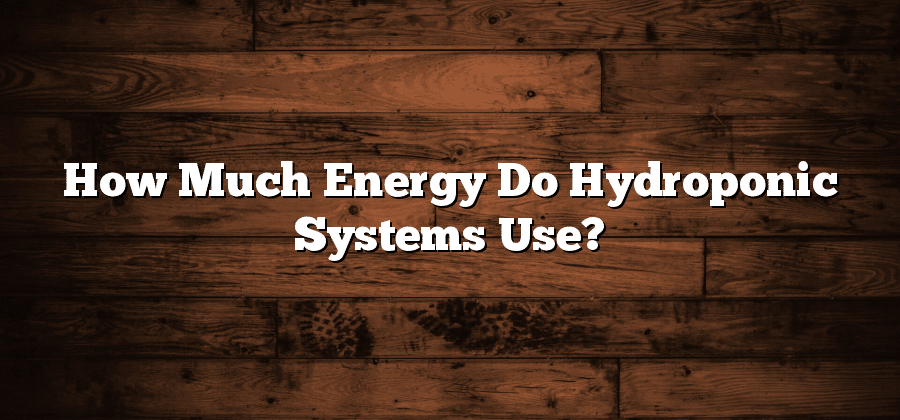Importance of Energy Efficiency in Hydroponic Systems
Hydroponic systems have revolutionized the way we grow plants by providing better control over environmental factors and maximizing space utilization. However, one aspect that often gets overlooked is the energy consumption of these systems. Energy efficiency is paramount in hydroponic systems, not only to reduce operating costs but also to minimize the environmental impact.
By optimizing energy efficiency in hydroponic systems, growers can significantly reduce their reliance on traditional energy sources, such as electricity. This not only leads to cost savings but also helps in reducing carbon emissions and making the entire process more sustainable. Moreover, as energy costs continue to rise, it becomes increasingly crucial for hydroponic growers to focus on efficiently utilizing energy without compromising on plant productivity. By incorporating energy-efficient practices and technologies, such as LED lights and energy-efficient climate control systems, growers can create a more environmentally friendly and economically viable operation.
Understanding the Energy Requirements of Hydroponics
Hydroponics, a method of cultivating plants without soil, is gaining popularity due to its numerous benefits such as higher yields, efficient use of water, and the ability to grow crops in limited spaces. However, one crucial aspect of hydroponics that often goes unnoticed is its energy requirements. Understanding the energy requirements of hydroponic systems is essential in order to optimize their efficiency, minimize costs, and reduce environmental impact.
The energy requirements of hydroponic systems can be attributed to various factors. One of the primary contributors to energy consumption is the use of artificial lighting. Unlike traditional farming methods that rely on natural sunlight, hydroponic systems rely on artificial lights, such as light-emitting diodes (LEDs), to provide the necessary spectrum and intensity of light for optimal plant growth. These lights not only consume energy but also generate heat, which requires additional energy for cooling and ventilation systems. Hence, choosing energy-efficient lighting options and properly managing heat generation can significantly reduce the energy requirements of hydroponic systems.
Key Factors Influencing Energy Consumption in Hydroponics
Hydroponic systems offer an efficient and innovative approach to growing plants without the need for soil. However, it is crucial to understand the key factors that influence energy consumption in these systems. By identifying and addressing these factors, growers can optimize energy usage and promote sustainability in their hydroponic operations.
One of the primary factors influencing energy consumption in hydroponics is lighting. Since these systems often require artificial lighting to supplement or replace natural sunlight, the type of lighting used and the duration of light exposure play a critical role. High-intensity discharge (HID) lamps, such as metal halide and high-pressure sodium bulbs, are commonly used in hydroponics due to their ability to provide the appropriate light spectrum for plant growth. However, these lamps can be energy-intensive compared to more energy-efficient LED lights. Additionally, the duration and timing of light exposure should align with the specific needs of the plants, avoiding excessive lighting that may result in unnecessary energy usage.
Measuring Energy Use in Hydroponic Systems
One of the key aspects in optimizing energy efficiency in hydroponic systems is accurately measuring energy use. By understanding the energy consumption patterns, growers can identify areas where energy consumption can be reduced and make informed decisions to improve overall efficiency.
Measuring energy use in hydroponic systems involves monitoring and recording the energy consumed by various components, such as lighting, heating, ventilation, and water circulation systems. This data provides valuable insights into the energy requirements of the system and helps identify any inefficiencies or areas where improvements can be made. By collecting accurate energy use data, growers can establish benchmarks, set targets for energy reduction, and track the effectiveness of energy-saving measures they implement. This information is instrumental in making informed decisions and optimizing the energy efficiency of hydroponic operations.
Comparing Energy Consumption in Different Hydroponic Setups
Hydroponics is becoming an increasingly popular method for growing plants, especially in urban areas where land is limited. However, while hydroponic systems offer many benefits, it is important to consider the energy consumption associated with these setups. Comparing energy consumption in different hydroponic setups is crucial in order to optimize efficiency and minimize environmental impact.
One key factor influencing energy consumption in hydroponic systems is the type of lighting used. Traditional high-pressure sodium (HPS) lamps are commonly used in hydroponics, but they can be energy-intensive. LED lights, on the other hand, have gained recognition for their energy efficiency and ability to provide tailored light spectrums. Studies have shown that replacing HPS lamps with LED lights can significantly reduce energy consumption in hydroponic setups. However, the initial costs associated with LED lighting systems can be prohibitive for some growers, making the decision more complex. Therefore, comparing energy consumption between different lighting options is an important step in determining the most cost-effective solution for a hydroponic system.






